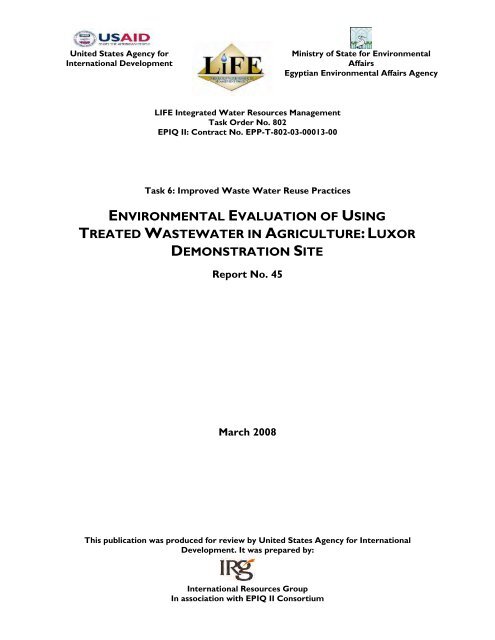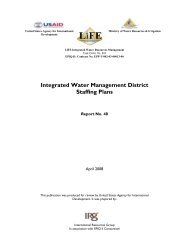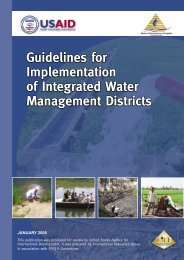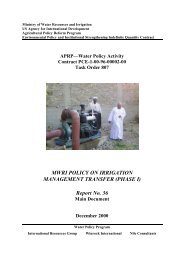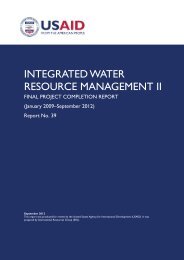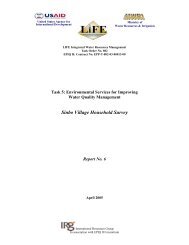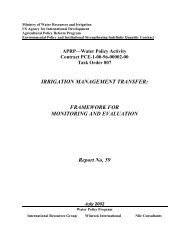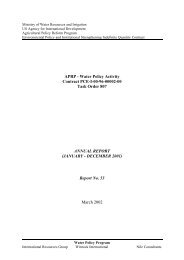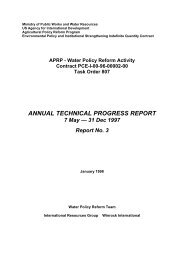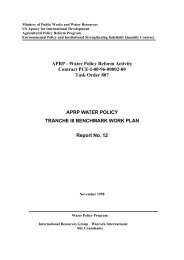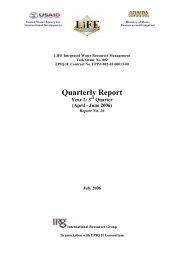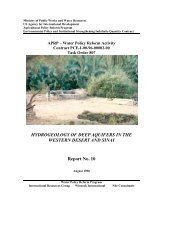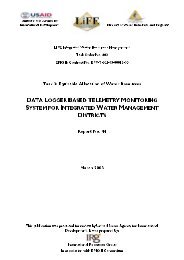Report 45 Task 6 Environmental Evaluation Luxor Demo Site
Report 45 Task 6 Environmental Evaluation Luxor Demo Site
Report 45 Task 6 Environmental Evaluation Luxor Demo Site
You also want an ePaper? Increase the reach of your titles
YUMPU automatically turns print PDFs into web optimized ePapers that Google loves.
United States Agency for<br />
International Development<br />
Ministry of State for <strong>Environmental</strong><br />
Affairs<br />
Egyptian <strong>Environmental</strong> Affairs Agency<br />
LIFE Integrated Water Resources Management<br />
<strong>Task</strong> Order No. 802<br />
EPIQ II: Contract No. EPP-T-802-03-00013-00<br />
<strong>Task</strong> 6: Improved Waste Water Reuse Practices<br />
ENVIRONMENTAL EVALUATION OF USING<br />
TREATED WASTEWATER IN AGRICULTURE: LUXOR<br />
DEMONSTRATION SITE<br />
<strong>Report</strong> No. <strong>45</strong><br />
March 2008<br />
This publication was produced for review by United States Agency for International<br />
Development. It was prepared by:<br />
International Resources Group<br />
In association with EPIQ II Consortium
US Agency<br />
for International Development<br />
Ministry of State for <strong>Environmental</strong> Affairs<br />
Egyptian <strong>Environmental</strong> Affairs Agency<br />
LIFE Integrated Water Resources Management<br />
<strong>Task</strong> Order No. 802<br />
EPIQ II: Contract No. EPP-T-802-03-00013-00<br />
<strong>Task</strong> 6: Improved Waste Water Reuse Practices<br />
ENVIRONMENTAL EVALUATION OF USING<br />
TREATED WASTEWATER IN AGRICULTURE: LUXOR<br />
DEMONSTRATION SITE<br />
<strong>Report</strong> No. <strong>45</strong><br />
This report was prepared by ECODIT, Inc.<br />
March 2008<br />
DISCLAIMER<br />
The authors views expressed in this publication do not necessarily reflect the views of the United<br />
States Agency for International Development or the United States Government
<strong>Task</strong> 6. <strong>Environmental</strong> <strong>Evaluation</strong> of Using Treated Wastewater in Agriculture<br />
ACKNOWLEDGEMENTS<br />
This report was undertaken as a joint activity of the Ministry of State for <strong>Environmental</strong> Affairs<br />
(MSEA), Egyptian <strong>Environmental</strong> Affairs Agency (EEAA), and the Livelihood and Income from the<br />
Environment–Integrated Water Resources Management Project (LIFE–IWRM) Team.<br />
The LIFE–IWRM is a joint activity of the Ministry of Water Resources and Irrigation (MWRI),<br />
Ministry of State for <strong>Environmental</strong> Affairs (MSEA), and the United States Agency for International<br />
Development (USAID) and is being implemented by a consortium led by International Resources<br />
Group, Ltd. (IRG).<br />
In particular, the LIFE–IWRM Chief of Party, Dr. Jeffery Fredericks; <strong>Task</strong> 6 Manager, Dr. Wadie<br />
F. Mankarious; the LIFE IWRM team; and Karim El-Jisr, ECODIT Consultant; would like to<br />
acknowledge the contributions and support of the management and staff of MSEA/EEAA, MALR and<br />
MWRI. Policy and technical guidance provided by the following individuals was significant and greatly<br />
appreciated:<br />
• Dr. Mawaheb Abu Elazm, Chairperson of EEAA / MSEA<br />
• Dr. Moustafa El Hakeem, Afforestation Consultant, EEAA, and Technical Advisor to the<br />
Minister<br />
• Eng. Mohamed Ahmed Moustafa, Under Secretary for Reforestation and Environment,<br />
MALR<br />
• Eng. Mohamed Hamed, MWRI<br />
• Eng. Wafaa Faltaous, Cognizant Technical Officer (CTO) for the project, USAID.<br />
LIFE–IWRM i INTERNATIONAL RESOURCES GROUP
<strong>Task</strong> 6. <strong>Environmental</strong> <strong>Evaluation</strong> of Using Treated Wastewater in Agriculture<br />
TABLE OF CONTENTS<br />
Acknowledgements ........................................................................................................................ i<br />
Table of Contents .......................................................................................................................... ii<br />
List of Tables ............................................................................................................................... iii<br />
List of Figures .............................................................................................................................. iii<br />
Acronyms and Abbreviations .................................................................................................... iv<br />
Executive Summary ...................................................................................................................... 1<br />
1. Introduction ...................................................................................................................... 2<br />
1.1. Background .................................................................................................................... 2<br />
1.2. Purpose ............................................................................................................................... 2<br />
1.3. Methodology .................................................................................................................... 2<br />
1.4. <strong>Report</strong> Organization ......................................................................................................... 2<br />
2. <strong>Environmental</strong> evaluation ............................................................................................... 3<br />
2.1. <strong>Site</strong> Description ............................................................................................................... 3<br />
2.2. Group 1: Treated Wastewater .......................................................................................... 5<br />
2.2.1. Baseline................................................................................................................ 5<br />
2.2.2. Water Quantity Monitoring Results ...................................................................... 5<br />
2.2.3. Water Quality Monitoring Results ......................................................................... 6<br />
2.3. Group 2: Soil .................................................................................................................... 6<br />
2.3.1. Baseline................................................................................................................ 6<br />
2.3.2. Monitoring results ................................................................................................ 7<br />
2.4. Group 3: Groundwater .................................................................................................... 8<br />
2.4.1. Baseline................................................................................................................ 8<br />
2.4.2. Monitoring results ................................................................................................ 9<br />
2.5. Group 4: Crops ................................................................................................................ 9<br />
2.5.1. Baseline................................................................................................................ 9<br />
2.5.2. Monitoring Results ............................................................................................. 10<br />
2.6. Group 5: Health and Safety ............................................................................................. 12<br />
2.6.1. Baseline.............................................................................................................. 12<br />
2.6.2. Monitoring Results ............................................................................................. 12<br />
3. Conclusions and recommendations ............................................................................. 13<br />
3.1. Conclusions .................................................................................................................. 13<br />
3.2. Recommendations .......................................................................................................... 13<br />
3.2.1. End-Users .......................................................................................................... 13<br />
3.2.2. Government of Egypt ......................................................................................... 13<br />
LIFE–IWRM ii INTERNATIONAL RESOURCES GROUP
<strong>Task</strong> 6. <strong>Environmental</strong> <strong>Evaluation</strong> of Using Treated Wastewater in Agriculture<br />
List of Tables<br />
Table 1 Summary of <strong>Environmental</strong> Monitoring Plan in <strong>Luxor</strong> ................................................................ 3<br />
Table 2 Monitoring Laboratories and Facilities ........................................................................................... 3<br />
Table 3 Limit Values for Treated Municipal Wastewater Reused in Agriculture (mg/l) .................... 5<br />
Table 4 Initial Effluent Test Results from Lagoon (baseline) ..................................................................... 5<br />
Table 5 Summary of Tests Conducted on TWW ..................................................................................... 6<br />
Table 6 Summary of Soil Tests ....................................................................................................................... 7<br />
Table 7 Complete Soil Tests Results ............................................................................................................. 8<br />
Table 8 Summary of Groundwater Tests ..................................................................................................... 9<br />
Table 9 Approved Crop List Irrigated with Treated Wastewater .......................................................... 10<br />
Table 10 <strong>Luxor</strong> <strong>Demo</strong> Crops ......................................................................................................................... 10<br />
Table 11 Summary of Crop Tests .................................................................................................................. 11<br />
Table 12 Risk Reduction Measures for Farm Workers, Crop Handlers and Graduates .................... 12<br />
List of Figures<br />
Figure 1: Location Map .........................................................................................................................................4<br />
Figure 2 Irrigation System Layout .....................................................................................................................4<br />
Figure 3: General Map Of The <strong>Demo</strong> <strong>Site</strong> And Surrounding Wells ..........................................................8<br />
Figure 4 Crop Layout ............................................................................................................................................11<br />
LIFE–IWRM iii INTERNATIONAL RESOURCES GROUP
<strong>Task</strong> 6. <strong>Environmental</strong> <strong>Evaluation</strong> of Using Treated Wastewater in Agriculture<br />
ACRONYMS AND ABBREVIATIONS<br />
AAU<br />
AED<br />
APRP<br />
ASC<br />
BCWUA<br />
BOD<br />
C<br />
CAD<br />
CD<br />
CDA<br />
CLAC<br />
CLEQM<br />
COD<br />
CTO<br />
CY<br />
DAI<br />
EEAA<br />
EEPP<br />
EMP<br />
EPADP<br />
EPIQ<br />
ET<br />
FC<br />
GB<br />
GIS<br />
GOE<br />
GPS<br />
GW<br />
GWS<br />
HD<br />
hp<br />
IAS<br />
IBRD<br />
ID<br />
IDS<br />
IIIMP<br />
IIP<br />
IRG<br />
IRMU<br />
IRs<br />
IRU<br />
IS<br />
IT<br />
IWMD<br />
IWMU<br />
IWRM<br />
IWRMP<br />
Agricultural Administrative Unit<br />
Academy for Educational Development (a US-based entity providing USAID-funded<br />
assistance regarding environmental education and awareness)<br />
Agricultural Policy Reform Program<br />
Alliance Steering Committee<br />
Branch Canal Water User Association<br />
Biological Oxygen Demand<br />
Centigrade<br />
Computer aided design<br />
Central Directorate<br />
Community Development Association<br />
Central Lab for Agricultural Climate<br />
Central Laboratory for <strong>Environmental</strong> Quality Monitoring (MWRI)<br />
Chemical oxygen demand<br />
Cognizant Technical Officer (the USAID person responsible for supervising a technical<br />
assistance contractor)<br />
Calendar Year<br />
Development Alternatives, Inc. (a Washington DC-based consulting firm working with<br />
IRG to implement the project)<br />
Egyptian <strong>Environmental</strong> Affairs Agency<br />
Egyptian <strong>Environmental</strong> Policy Program (a USAID-funded program aimed at achieving<br />
environmental policy reform)<br />
<strong>Environmental</strong> Monitoring Plan<br />
Egyptian Public Authority for Drainage Projects (MWRI)<br />
<strong>Environmental</strong> Policy and Institutional Strengthening Indefinite Quantity Contract<br />
Evapotranspiration<br />
Field Capacity<br />
Gigabyte<br />
Geographic Information System<br />
Government of Egypt<br />
Global Positioning System<br />
Groundwater<br />
Groundwater Sector<br />
(Aswan) High Dam<br />
Horsepower<br />
Irrigation Advisory Service<br />
International Bank for Reconstruction and Development or World Bank<br />
Irrigation Department<br />
Irrigation and Drainage System<br />
Integrated Irrigation Improvement and Management Project<br />
Irrigation Improvement Project<br />
International Resources Group (a Washington DC-based consulting firm that is prime<br />
contractor for the IWRMP)<br />
Integrated Water Management Unit<br />
Intermediate Results<br />
MWRI Institutional Reform Unit<br />
Information Systems<br />
Information Technology<br />
Integrated Water Management District<br />
Integrated Water Management Unit (A unit of MWRI)<br />
Integrated Water Resources Management<br />
Integrated Water Resource Management Project<br />
LIFE–IWRM iv INTERNATIONAL RESOURCES GROUP
<strong>Task</strong> 6. <strong>Environmental</strong> <strong>Evaluation</strong> of Using Treated Wastewater in Agriculture<br />
jpg, jpeg<br />
KB<br />
kg<br />
LAN<br />
LIFE<br />
LOE<br />
M&E<br />
MALR<br />
MED<br />
mg/l<br />
MIC<br />
MISD<br />
MOE<br />
MOHP<br />
MOU<br />
MSEA<br />
MWH<br />
MWRI<br />
NASA<br />
NGO<br />
NPK<br />
NSCE<br />
NWRC<br />
O&M<br />
OJT<br />
PC<br />
pH<br />
PM&E<br />
ppm<br />
PWP<br />
RSC/WP<br />
RWS<br />
SIRs<br />
SOs<br />
SS<br />
STTA<br />
SWERI<br />
TA<br />
TDS<br />
TOR<br />
TRG<br />
TS<br />
TSS<br />
TWW<br />
UPS<br />
USAID<br />
USB<br />
WCU<br />
WDC<br />
WPRP<br />
WQU<br />
WUA<br />
WWTP<br />
Joint Photographic Expert Group (computing)<br />
Kilobyte<br />
Kilogram(s)<br />
Local Area Network<br />
Livelihood and Income from the Environment (project)<br />
Level of Effort<br />
Monitoring and <strong>Evaluation</strong><br />
Ministry of Agriculture and Land Reclamation<br />
MWRI Mechanical & Electrical Department<br />
milligrams per liter<br />
MWRI Ministry Information Center<br />
Matching Irrigation Supply and Demand<br />
Ministry of Education<br />
Ministry of Health and Population<br />
Memorandum of Understanding<br />
Ministry of Sate for <strong>Environmental</strong> Affairs<br />
Montgomery Watson Harza<br />
Ministry of Water Resources and Irrigation<br />
(United States) National Aeronautics and Space Administration<br />
Non-governmental Organization<br />
nitrogen, phosphorus, and potassium (especially in chemical fertilizers)<br />
North South Consultants Exchange<br />
(MWRI) National Water Research Center<br />
Operation and Maintenance<br />
On-the-Job Training<br />
Personal Computer<br />
Potential of Hydrogen ions (measure of acidity or alkalinity)<br />
Performance Monitoring and <strong>Evaluation</strong><br />
Parts per Million<br />
Permanent Wilting Point<br />
Red Sea Coastal/Water Project (short name for USAID-funded Red Sea Coastal and<br />
Improved Water Resource Management Project)<br />
Relative Water Supply<br />
Sub-Intermediate Results<br />
Strategic Objectives<br />
Suspended Solids<br />
Short-term Technical Assistance<br />
Soils, Water, and Environment Research Institute (MALR)<br />
Technical assistance<br />
Total Dissolved Solids<br />
Terms of Reference<br />
Training Resources Group<br />
Transition State (chemical)<br />
Total Suspended Solids<br />
Treated Wastewater<br />
Uninterruptible Power Supply Device<br />
United States Agency for International Development<br />
Universal Serial Bus (computing)<br />
MWRI Water Communication Unit<br />
MWRI Central Water Distribution Center<br />
Water Resources Results Package<br />
MWRI Water Quality Unit<br />
Water User Association<br />
Wastewater Treatment Plant<br />
LIFE–IWRM v INTERNATIONAL RESOURCES GROUP
<strong>Task</strong> 6. <strong>Environmental</strong> <strong>Evaluation</strong> of Using Treated Wastewater in Agriculture<br />
EXECUTIVE SUMMARY<br />
LIFE Integrated Water Resources Management Project has demonstrated the technical feasibility of<br />
reusing treated wastewater (TWW) in agriculture in a manner that is environmentally safe and<br />
compliant. The Project managed a 10-Feddan water reuse site in <strong>Luxor</strong> located near the new<br />
wastewater treatment plant. The site received treated wastewater from the nearest maturation<br />
pond and produced a number of commercial crops including flax, cut flowers and ornamental plants,<br />
Jojoba, Jatropha, and Sorghum. The first plantation started in winter 2005. The crops were selected<br />
according to the list posted under Grade-B of treated wastewater in the Egyptian Code for Reuse of<br />
Treated Wastewater in Agriculture.<br />
This report presents an environmental evaluation of the demo site, two years after the demo site<br />
was established. The evaluation examined five monitoring groups:<br />
Treated wastewater (physical, chemical and biological parameters);<br />
• Soil;<br />
• Groundwater;<br />
• Crops; and<br />
• Health & Safety.<br />
The results show that:<br />
• Reusing treated wastewater (Grade B) in agriculture is safe provided precautions are taken<br />
and followed through<br />
• Two years of continued irrigation using TWW showed no adverse impacts on soil, plant,<br />
groundwater and health.<br />
• Because the project timeframe was short, longer-term monitoring would be required to<br />
confirm the results.<br />
This report also presents a set of recommendations for reuse of treated wastewater in agriculture.<br />
Recommendations for End-Users include:<br />
• Use advanced irrigation techniques (minimize flood irrigation) on sandy soils<br />
• Improve soil fertility if using treated wastewater on new lands.<br />
• Implement risk reduction measures for farm workers and crop handlers.<br />
• Implement basic self monitoring tests.<br />
• Recommendations for the Government of Egypt include:<br />
• More graduate training on water reuse practices.<br />
• Disseminate pertinent findings on water reuse (EEAA newsletter, TV, journals).<br />
• Monitor the long-term effects of water reuse on biodiversity (especially birds, mammals,<br />
and reptiles).<br />
LIFE IWRM 1<br />
INTERNATIONAL RESOURCES GROUP
<strong>Task</strong> 6. <strong>Environmental</strong> <strong>Evaluation</strong> of Using Treated Wastewater in Agriculture<br />
1. INTRODUCTION<br />
1.1. Background<br />
Egypt has been using treated wastewater to produce wood and other industrial products since the<br />
early 1990s. The Ministry of Agriculture and Land Reclamation (MALR) and the Ministry of State for<br />
<strong>Environmental</strong> Affairs (MSEA) have to date established 24 water-reuse projects across the country<br />
including one in <strong>Luxor</strong> where they grow African Mahogany (Khaya senegalensis), mulberry (Morus<br />
spp), and Physic Nut (Jatropha curcas). So far, these projects have been exclusively government<br />
driven and private sector participation is noticeably absent. An inter-ministerial committee approved<br />
in April 2005 the Egyptian Water Reuse Code (ministerial decree No. 171/2005).<br />
IRG and ECODIT designed <strong>Task</strong> #6 Improved Wastewater Reuse Practices under the LIFE<br />
Integrated Water Resources Management Project (LIFE IWRM) to demonstrate the technical<br />
feasibility of treated waste water reuse for irrigation in a manner that is environmentally safe and<br />
compliant. Over a period of two years, the Project managed a 10-Feddan water reuse site in <strong>Luxor</strong>,<br />
near the <strong>Luxor</strong> wastewater treatment plant. The site was irrigated using treated wastewater<br />
pumped from the nearest maturation pond. The project cultivated a number of commercial crops<br />
including Jojoba, Jatropha, Sorghum, Flax, cut flowers and ornamental plants.<br />
1.2. Purpose<br />
The purpose of this report is to review and interpret all test results obtained or collected during the<br />
project in relation to preset environmental monitoring parameters; treated wastewater,<br />
groundwater, soil, crops and occupational health. The report findings provide a solid basis for<br />
replicating water reuse projects on similar lands and under comparable climatic conditions.<br />
1.3. Methodology<br />
To prepare this report, the monitoring team:<br />
• Used the <strong>Environmental</strong> Monitoring Plan (EMP) for <strong>Task</strong> 6 which was prepared and<br />
approved in November 2005.<br />
• Consolidated and reviewed all test reports pertaining to treated wastewater, groundwater,<br />
soil, crops and worker’s health.<br />
• Visited the site in <strong>Luxor</strong> to discuss outstanding environmental issues with the local team.<br />
• Collected additional soil and groundwater samples to complete the environmental<br />
evaluation and sent those tests for analysis in <strong>Luxor</strong>.<br />
• Presented and discussed draft EMP findings with senior representatives from MSEA, MALR,<br />
MWRI and USAID, on 16/07/2007.<br />
1.4. <strong>Report</strong> Organization<br />
This report is organized into three chapters:<br />
1. Introduction<br />
2. <strong>Environmental</strong> <strong>Evaluation</strong><br />
3. Conclusions and Recommendations<br />
LIFE IWRM 2<br />
INTERNATIONAL RESOURCES GROUP
<strong>Task</strong> 6. <strong>Environmental</strong> <strong>Evaluation</strong> of Using Treated Wastewater in Agriculture<br />
2. ENVIRONMENTAL EVALUATION<br />
This <strong>Environmental</strong> <strong>Evaluation</strong> of Using Treated Wastewater in Agriculture is based on the<br />
<strong>Environmental</strong> Monitoring Plan (prepared by ECODIT) in November 2005. The Plan described five<br />
monitoring groups:<br />
1. Group 1: Treated wastewater (quantity, physical, chemical and bacteriological properties)<br />
2. Group 2: Soil<br />
3. Group 3: Groundwater<br />
4. Group 4: Crops<br />
5. Group 5: Workers’ Health<br />
Table 1 below summarizes the EMP including test parameters and frequency.<br />
Table 1 Summary of <strong>Environmental</strong> Monitoring Plan in <strong>Luxor</strong><br />
Group Parameters Frequency Laboratory<br />
Group 1: TWW Turbidity, BOD, COD, SS, DO,<br />
residual chlorine, oil & grease, heavy<br />
metals, nematode cells or eggs, E.<br />
Coli and/or total coliform<br />
Quarterly<br />
(increase frequency of<br />
test results show no<br />
compliance)<br />
CLEQM,<br />
MOHP Lab,<br />
And <strong>Luxor</strong><br />
WWTP Lab.<br />
Group 2: Soil Organic matter, macro & micronutrients,<br />
Bi-annual<br />
SWERI<br />
EC, alkalinity, heavy metals<br />
Group 3:<br />
Depth to water table, pH, EC, Bi-annual<br />
CLEQM<br />
Groundwater nitrates and fecal coliform<br />
Group 4: Crops Basis nutrients (N, P, K), total At harvest (crop SWERI<br />
Group 5: Health &<br />
Safety<br />
coliform and heavy metals<br />
Training on H&S<br />
• Information/warning<br />
signs<br />
• Medical check-up<br />
• Vaccination<br />
• Protective clothing<br />
• Record keeping<br />
specific)<br />
Year 2<br />
One-time (replace if necessary)<br />
Pre-employment<br />
Pre-employment<br />
Daily<br />
Weekly<br />
Facilities and laboratories used for environmental monitoring are presented in Table 2.<br />
Table 2 Monitoring Laboratories and Facilities<br />
Item<br />
Laboratory<br />
1 <strong>Luxor</strong> Wastewater Treatment Plant Lab (WWTP)<br />
2 Ministry of Agriculture and Land Reclamation / Central Lab for Food and Fodder (Giza)<br />
3 Ministry of Agriculture and Land Reclamation / Soil Lab (<strong>Luxor</strong>)<br />
4 Central Laboratory for <strong>Environmental</strong> Quality Monitoring (CLEQM) / MWRI<br />
5 El-Amal Medical Lab (<strong>Luxor</strong>)<br />
6 <strong>Luxor</strong> International Hospital<br />
7 Ministry of Health and Population Central Lab – Water Dept.<br />
2.1. <strong>Site</strong> Description<br />
The <strong>Luxor</strong> demo site is located on a 10 Feddan area located adjacent to the <strong>Luxor</strong> waste water<br />
treatment plant maturation ponds. Several other important features are located within a one km<br />
radius from the site including vast Jatropha plantations, at least three private wells (one of which is<br />
reportedly dry), Khaya plantations, and other units of the treatment plants including facultative<br />
LIFE IWRM 3<br />
INTERNATIONAL RESOURCES GROUP
<strong>Task</strong> 6. <strong>Environmental</strong> <strong>Evaluation</strong> of Using Treated Wastewater in Agriculture<br />
ponds and sludge drying beds. The site proper had never been cultivated prior to the construction<br />
of the demo site. A location map is shown in Figure 1<br />
The irrigation system consists of a pumping station with a design outflow of 60 m3/hour, a filtration<br />
unit, and a distribution network. The irrigation network is composed of a 125 mm main line, 75 mm<br />
sub-mains, 18 mm laterals, and different sizes of drippers. Figure 2 shows the layout of the demo site<br />
irrigation system<br />
Figure 1: Location Map<br />
Figure 2 Irrigation System Layout<br />
LIFE IWRM 4<br />
INTERNATIONAL RESOURCES GROUP
<strong>Task</strong> 6. <strong>Environmental</strong> <strong>Evaluation</strong> of Using Treated Wastewater in Agriculture<br />
2.2. Group 1: Treated Wastewater<br />
The <strong>Luxor</strong> demo site was designed to meet Grade B treated wastewater. The limit values for shortterm<br />
use (less than 20 years) of treated wastewater are presented in Table 3.<br />
Table 3 Limit Values for Treated Municipal Wastewater Reused in Agriculture (mg/l)<br />
Treatment Grade Requirements A B C<br />
Effluent limit values for<br />
BOD and SS<br />
BODs < 20 < 60 < 400<br />
SS < 20 < 50 < 250<br />
Effluent limit value for fecal<br />
coliform and Nematode<br />
cells or eggs (per liter)<br />
Fecal coliform<br />
count (2) in 100 cm 3<br />
Count of Nematode<br />
cells or eggs per<br />
liter<br />
* Egyptian Water Reuse Code (Grade B)<br />
< 1000 < 5000 Unspecified<br />
< 1 < 1 Unspecified<br />
2.2.1. Baseline<br />
The quality of the treated wastewater in the maturation (and polishing) lagoons was good and<br />
compliant before implementing the demo site. The <strong>Luxor</strong> Wastewater Treatment Plant (WWTP)<br />
environmental laboratory conducts routine sampling and analysis of the influent and effluent water.<br />
Standard tests include pH, alkalinity, TSS, TDS, TS, BOD, coliform and Chlorophyll A. At the<br />
request of LIFE, the WWTP laboratory agreed to collect and analyze daily samples from the lagoon<br />
over a period of one week in September 2005 (called baseline). Those test results are summarized<br />
in Table 4.<br />
Table 4 Initial Effluent Test Results from Lagoon (baseline)<br />
Temp pH BOD COD DO TDS TSS Coliform Count<br />
Average 30.2 8.17 25.8 32.8 7.58 466.4 29 3,060<br />
Source: Data provided by <strong>Luxor</strong> laboratory, September 2005<br />
2.2.2. Water Quantity Monitoring Results<br />
Continuous flow water meters were installed to measure daily flow discharges from the main and<br />
subsidiary irrigation distribution systems. A summary of the water delivered to the <strong>Luxor</strong> <strong>Demo</strong><br />
site are given in Annex B. A review of those readings shows that the demo site pumped in a single<br />
year (from 01/01/06 to 31/12/06) 127,000 m3 of treated wastewater from the pond. This is<br />
equivalent to 12,700 m3/feddan/year (assuming a total irrigated area of 10 Feddan). The highest<br />
quantity was recorded in January (11,940 m3) when all the plots were newly planted, and the lowest<br />
quantity was in February (7,590 m3). An agricultural field with similar soil and climatic conditions<br />
would on average consume between 5,000 (drip/sprinkler) to 7,000 (surface irrigation)<br />
m3/feddan/per year. The high initial water use can be attributed to the need for leaching of the soil<br />
and to the fact that several of the crops were irrigated using furrow and flood irrigation instead of<br />
drip. It is safe to conclude that irrigation efficiency in <strong>Luxor</strong> can be improved to reduce the total<br />
quantities of water pumped (whatever the source). Less water will minimize the risk of<br />
groundwater contamination but may require more leaching to offset the impact of accumulated salts.<br />
LIFE IWRM 5<br />
INTERNATIONAL RESOURCES GROUP
<strong>Task</strong> 6. <strong>Environmental</strong> <strong>Evaluation</strong> of Using Treated Wastewater in Agriculture<br />
2.2.3. Water Quality Monitoring Results<br />
Routine samples of TWW were collected from the treatment plant and sent to different<br />
laboratories for testing during the program. Table 5 presents summary of the test schedule.<br />
Table 5 Summary of Tests Conducted on TWW<br />
Laboratory Date of Sampling Parameters<br />
<strong>Luxor</strong> WWTP* Routine (every 10 days) BOD, COD, TSS, total coliform<br />
Central Lab for <strong>Environmental</strong><br />
Quality Monitoring (MWRI)<br />
2005: May, Sep<br />
2006: Feb, Mar, Aug, Nov, Dec<br />
Physiochemical, major cations<br />
and anions, trace metals,<br />
microbiological<br />
Ministry of Public Health 2007: Mar, May BOD, COD, TDS, TSS<br />
(MOHP)<br />
* Samples collected by the WWTP personnel<br />
In the period from September 2005 (baseline) through June 2007, the quality of the TWW was<br />
generally compliant, below or near Egyptian limit values, for Grade B under the Egyptian Water<br />
Reuse Code.<br />
To minimize travel distance, it was decided during later stages of the pilot project to conduct water<br />
sample analysis at the water lab of the Ministry of Health and Population, in <strong>Luxor</strong>. Those tests,<br />
while not complete (total coliform was missing), produced BOD and TSS results that were slightly<br />
higher than the results reported by the WWTP lab or CLEQM. Those values were also slightly<br />
above their limit value. For example:<br />
• BOD was 69-104 mg/l (std is 60)<br />
• TSS was 64-140 mg/l (std is 50)<br />
A comparison of the values for turbidity and TSS before and after the filtration units showed an<br />
appreciable drop in those values. For example:<br />
• Turbidity dropped from 7.89 to 5.14 NTU (Mar 2006)<br />
• TSS dropped from 132 to 92 mg/l (Aug 2006)<br />
• Turbidity dropped from 18.3 to 8.34 NTU (Nov 2006)<br />
The sand filters are therefore reducing suspended solids in treated wastewater and help prevent<br />
clogging in the irrigation network.<br />
2.3. Group 2: Soil<br />
2.3.1. Baseline<br />
In October 2005, the Project collected 24 soil samples from eight locations inside the demo site and<br />
from three different depths (0-30, 30-60, 60-90). The samples were analyzed at the MARL lab in<br />
Cairo: 1 physical tests were conducted on all 24 samples (8 locations) and chemical tests were<br />
conducted on 9 samples (3 locations). Physical tests include particle size distribution and chemical<br />
tests include: pH, electrical conductivity, anions and cations, CaCO 3, organic matter, and macro and<br />
micro nutrients. The soil in <strong>Luxor</strong> prior to the construction of the demo site had the following<br />
characteristics:<br />
• Texture: soil is loamy sand to sandy (>90 percent sand)<br />
1 Ministry of Agriculture/Agricultural Research Centre/Soils, Water & Environment Research Institute (SWERI)/Unit of<br />
Analysis & Studies. Giza, Cairo.<br />
LIFE IWRM 6<br />
INTERNATIONAL RESOURCES GROUP
<strong>Task</strong> 6. <strong>Environmental</strong> <strong>Evaluation</strong> of Using Treated Wastewater in Agriculture<br />
• Alkalinity: high, pH ranged from 8.05 to 8.<strong>45</strong><br />
• Electrical Conductivity: moderate to high (about 5 dS/m)<br />
• Organic matter: very low (expected), OM ranges from 0.03 to 0.53 percent<br />
• Macronutrients: Nitrogen (N) was 60-120 ppm, Phosphorous (P) was 1-5 ppm, and<br />
Potassium (K) was 80-170 ppm<br />
2.3.2. Monitoring results<br />
Partial soil tests were conducted in October 2006 (to investigate the causes of poor growth in the<br />
sorghum plot) and a complete soil test was in July 2007. Table 6 presents a summary of the test<br />
program.<br />
Table 6 Summary of Soil Tests<br />
Laboratory<br />
Date of<br />
Sampling<br />
Sampling Method<br />
Regional lab for soil October 2006 One sample only from<br />
fertility, <strong>Luxor</strong> (MALR)<br />
sorghum plot (depth 0-30)<br />
Regional lab for soil July 2007 Samples collected from 3<br />
fertility, <strong>Luxor</strong> (MALR)<br />
locations (A, B, C) and from<br />
three different depths (0-30,<br />
30-60, 60-90), plus one<br />
composite sample (0-30)<br />
Parameters<br />
pH, percent salts,<br />
CaCO3, major cations<br />
and anions, and macro<br />
nutrients (Nitrogen,<br />
Phosphorous,<br />
Potassium)<br />
The sample collected from the sorghum plot in October 2006 showed that:<br />
• N had dropped from 60-120 ppm (baseline) to 10 ppm just before harvesting the crop;<br />
• P had increased from 1-5 ppm (baseline) to 22 ppm before harvesting the crop; and<br />
• K had remained unchanged (130 ppm compared to 80-170 prior to planting).<br />
It can be concluded that one sorghum cycle depleted soil nutrient reserves; that soil fertility, already<br />
low before planting, had declined even further. This is not surprising considering that the soil is<br />
sandy (and therefore has a very low cation exchange capacity) and soil organic matter is close to nil<br />
(organic matter preserves soil moisture and prevents nutrient leaching). Excess irrigation may have<br />
contributed to reducing soil fertility as excess water will leach sandy soils and thereby displace soil<br />
nutrients. While wastewater will bring nutrients to the soil, wastewater cannot replenish or restore<br />
soil nutrient reserves without adequate soil management practices. As stated by the Ministry of<br />
Agriculture and Land Reclamation: improving soil fertility in reclaimed lands in Egypt requires a<br />
battery of soil conditioners including: 2<br />
• Manure: about 20 m3 per feddan (followed by deep tilling)<br />
• Sulfur: about 1 tone per feddan (followed by deep tilling)<br />
• Commercial fertilizer (NPK)<br />
• Micronutrients: based on soil conditions and crop requirements<br />
The full tests conducted at the demo site in <strong>Luxor</strong> in July 2007 showed that:<br />
• Alkalinity had remained high, pH ranged from 8.2 to 8.9<br />
• Total dissolved salts had dropped (from 0.03% to 0.2%)<br />
• Nitrogen had dropped to 20-40 ppm<br />
• Phosphorous & Potassium had increased slightly to 6-9 ppm and 140-242 ppm, respectively<br />
Table 7 shows the full results of the soil tests.<br />
2 Translated and adapted from the MARL test report (Regional Lab for Soil Fertility)<br />
LIFE IWRM 7<br />
INTERNATIONAL RESOURCES GROUP
<strong>Task</strong> 6. <strong>Environmental</strong> <strong>Evaluation</strong> of Using Treated Wastewater in Agriculture<br />
Table 7 Complete Soil Tests Results<br />
Plot Depth (cm) pH<br />
TDS<br />
CaCO<br />
(%)<br />
3<br />
K Na Mg CA So4 Ci Hco3<br />
A 0-30 8.3 0.08 14.4 0.3 1.6 0.4 1.5 2.7 0.44 0.66<br />
30-60 8.2 0.1 18.5 0.2 2.04 0.6 2.2 3.94 0.44 0.66<br />
60-90 8.6 0.2 10.3 0.2 3.4 1.7 3.7 7.9 0.44 0.66<br />
B 0-30 8.4 0.1 11.9 0.2 1.8 1.4 2.2 4.5 0.44 0.66<br />
30-60 8.9 0.1 13.2 0.2 2.5 1.4 2.2 4.98 0.44 0.88<br />
60-90 8.4 0.1 22.2 0.2 2.8 0.4 3.5 5.36 0.66 0.88<br />
C 0-30 8.2 0.05 18.5 0.3 0.9 0.5 1.3 5.58 0.66 0.66<br />
30-60 8.8 0.03 20.6 0.2 0.8 0.3 1.3 1.28 0.44 0.88<br />
60-90 8.8 0.03 17.7 0.2 0.7 0.3 1.3 0.96 0.88 0.66<br />
Composite 8.3 0.1 15.6 0.5 2.5 0.4 3.3 4.94 1.1 0.66<br />
2.4. Group 3: Groundwater<br />
2.4.1. Baseline<br />
In February 2005, the Project collected a groundwater sample from a 20-meter deep (production)<br />
well located 1 km west of the demo site, near the forested area. The sample was analyzed at<br />
CLEQM (MWRI). Test results indicated no fecal contamination. According to Mr. Salah Eldine<br />
Ramadan, Director of the Soil Fertility Lab in <strong>Luxor</strong> (MARL), “groundwater in <strong>Luxor</strong> in the area of<br />
the demo site [area also known as “Hbail”] is moderately to highly saline.” TDS values from<br />
neighboring farms ranged from 900 - 4,000 (1.4 to 6.25 dS/m). Figure 3 shows the demo site and<br />
surrounding wells.<br />
Figure 3: General Map of the <strong>Demo</strong> <strong>Site</strong> and Surrounding Wells<br />
LIFE IWRM 8<br />
INTERNATIONAL RESOURCES GROUP
<strong>Task</strong> 6. <strong>Environmental</strong> <strong>Evaluation</strong> of Using Treated Wastewater in Agriculture<br />
2.4.2. Monitoring results<br />
An observation well was constructed inside the demo site. Groundwater samples were collected on<br />
three different dates. Table 8 presents an overview of groundwater samples collected onsite and<br />
the date of sampling.<br />
Table 8 Summary of Groundwater Tests<br />
Location<br />
Date<br />
Chloride<br />
(mg/l)<br />
Alkalinity<br />
(mg/l)<br />
Ph<br />
Conduct.<br />
EC (Ds/m)<br />
Tss<br />
(mg/l)<br />
Ts<br />
(mg/l)<br />
Total<br />
Coliform<br />
(CFU/ml)<br />
On-site 340 140 6.9 4651 88 4192 700<br />
July 14, 2007<br />
Man-made<br />
forest<br />
80 810 7.4 1864 61 1678 0<br />
On-site 312 200 7.5 6750 136 4<strong>45</strong>5 600<br />
August 6, 2007<br />
Man-made<br />
forest<br />
80 1220 8.02 1840 50 1376 0<br />
On-site 360 160 6.8 4670 90 4200 800<br />
September 15, 2007<br />
Man-made<br />
forest<br />
72 780 7.3 1856 60 1670 0<br />
On-site 350 135 6.8 <strong>45</strong>63 85 4165 700<br />
October 14, 2007<br />
Man-made<br />
forest<br />
75 800 7.4 1855 58 1668 0<br />
On-site 180 140 8.18 5200 46 3<strong>45</strong>8 0<br />
November 25, 2007<br />
Man-made<br />
forest<br />
80 240 8.17 1750 40 794 0<br />
On-site 355 155 6.9 <strong>45</strong>20 90 4100 800<br />
December 17, 2007<br />
Man-made<br />
forest<br />
65 420 7.2 1740 55 1570 0<br />
On-site 320 220 7.6 6720 140 4460 0<br />
January 20, 2008<br />
Man-made<br />
forest<br />
76 1180 8.03 1780 48 1380 0<br />
Groundwater salinity as expected is high. This however cannot be attributed to the demo site<br />
because salinity was high before planting and TDS (total dissolved salts) values in treated wastewater<br />
were generally low to moderate.<br />
Coliform were present in some of the samples taken at the on-site well during several of the tests.<br />
The reasons are not know.<br />
2.5. Group 4: Crops<br />
2.5.1. Baseline<br />
The Project Committee selected five demonstration crops from Grade B & C of the Egyptian Water<br />
Reuse Code) for the demo site: flowers and ornamentals, flax, Jojoba, sorghum, and Jatropha, Crop<br />
selection was based on a number of factors:<br />
LIFE IWRM 9<br />
INTERNATIONAL RESOURCES GROUP
<strong>Task</strong> 6. <strong>Environmental</strong> <strong>Evaluation</strong> of Using Treated Wastewater in Agriculture<br />
• Water quality of the treated waste water<br />
• Climate and soil conditions<br />
• EEAA and MALR interests<br />
• Marketing and economic considerations.<br />
Table 9 Approved Crop List Irrigated with Treated Wastewater<br />
Grade Agricultural Group Recommendations<br />
G2-1: Fodder/Feed Crops<br />
Sorghum sp<br />
G2-2: Trees producing fruits with epicarp On condition that they are produced for<br />
processing purposes, such as lemons,<br />
mangoes, date palms and almonds<br />
B<br />
G2-3: Trees used for green belts around<br />
cities and afforestation of highways or<br />
roads<br />
Casuarina, camphor, Athel tamarix (salt<br />
tree), oleander, fruit-producing trees, date<br />
palms, and olive trees<br />
G2-4: Nursery plants<br />
Nursery plants of wood trees, ornamental<br />
plants, and fruit trees<br />
G2-5: Roses and cut flowers<br />
Local roses, eagle roses, onions (e.g.<br />
gladiolus)<br />
G2-6: Fiber crops<br />
Flax, jute, hibiscus, sisal<br />
G2-7: Mulberry for the production of silk Japanese mulberry<br />
C<br />
G3-1: Industrial oil crops<br />
Jojoba and Jatropha<br />
G3-2: Wood trees<br />
Khaya, camphor, and other wood trees<br />
Source: Egyptian Water Reuse Code (Table 5-1, Page 20)<br />
The demonstration site was divided into 18 plots of equal size (0.5 feddan each). The Project also<br />
planted a green fence to mark the perimeter and to serve as windbreak. Figure 4 shows the<br />
distribution of the crops in the demo site.<br />
2.5.2. Monitoring Results<br />
Details on <strong>Luxor</strong> <strong>Demo</strong> Cropping dates and other relevant information are summarized in Table 10.<br />
Table 10 <strong>Luxor</strong> <strong>Demo</strong> Crops<br />
Crop<br />
Growth<br />
Period<br />
(days)<br />
Planting Date Harvest Date Cultivated Area Yields Unit Yield/unit<br />
Roses All year Jan-06 Weekly cuts 9 Karat<br />
From January 07 To Cut<br />
December 07 Roses/Karat In<br />
(25,723 Roses) Year<br />
Feb, Mar, Apr 07 Bird of Paradise 11 K 71 Flowers/ Karat 6<br />
Ornamentals All Year Jan-06<br />
Indian Fig 1.5 K<br />
N/A<br />
Golden Dewdrop 2 K<br />
N/A Trees sold/fd N/A<br />
Flax 5 months<br />
Winter 2005 May-06 1.8Fd 1.3 Ton 0.72<br />
Ton/Fd<br />
Winter 2006 May-07 2.5 Fd 6.47 Ton 2.59<br />
Jojoba Perennial Dec 2005 N/A 2 Fd N/A Kg/tree N/A<br />
Jatropha Perennial Nov-05 Summer 2007 1 Fd (496 Tree) 2<strong>45</strong> Kg Kg/tree 0.5<br />
Cut 1: June 06 Cut1: 10.19 Ton 5.10<br />
Sorghum 3-4 months Summer2006 Cut 2: August 06 Cut 2: 6.87 Ton 3.44<br />
Tons/fd<br />
Cut 3 : September 06 Cut 3 : no yield No yield<br />
Summer2007 Cut 1: June 07 12 Karat Cut 1: 2.4 Ton 4.7<br />
Olives Perennial Dec 2008 N/A 3 Fd N/A Kg/tree N/A<br />
Crop samples were collected from all the plots except Jatropha (see summary in Table 11). Jatropha<br />
trees need at least 3-5 years to produce its first mature fruits.<br />
2858<br />
LIFE IWRM 10<br />
INTERNATIONAL RESOURCES GROUP
<strong>Task</strong> 6. <strong>Environmental</strong> <strong>Evaluation</strong> of Using Treated Wastewater in Agriculture<br />
Figure 4 Crop layout<br />
Table 11 Summary of Crop Tests<br />
Date Lab Sample Parameters<br />
27-Jun-06 CLFF Flax seeds Total and fecal Coliform<br />
10-Jul-06 CLFF Flax seeds Total bacterial count, total<br />
Enterococcus, total fungal<br />
count, Norwolk Brius<br />
13-Jun-06 <strong>Luxor</strong> WWTP Flax seeds, foliage, stalk and roots Total Coliform<br />
13-Jun-06 <strong>Luxor</strong> WWTP Sorghum foliage, stem and roots Total Coliform<br />
19-Aug-06 <strong>Luxor</strong> WWTP Cow milk* Total Coliform<br />
30-Aug-06 CLFF Roses, durenta, sorghum, Flax<br />
dried seeds<br />
Total Bacterial count,<br />
Coliform count,<br />
Enterococcus count and<br />
total fungal count<br />
27-May-07 <strong>Luxor</strong> WWTP Flax: whole seeds, stem, roots, Total Coliform<br />
and crushed seeds<br />
14-Jun-07 <strong>Luxor</strong> WWTP Sorghum: roots, stem and foliage Total Coliform<br />
The test results showed that:<br />
1. Ornamental plants (roses and durenta), dried and crushed flax seeds, and cow milk showed<br />
no microbiological contamination. This result was expected as the harvested parts of the<br />
plant (buds and stems) do not come in direct contact with irrigation water.<br />
2. Sorghum stem and roots showed low levels of total coliform (700 and 4,000 CFU,<br />
respectively). This result can be expected considering that the sorghum is flood irrigated<br />
(furrows) and the green stems drop to the soil at harvest.<br />
LIFE IWRM 11<br />
INTERNATIONAL RESOURCES GROUP
<strong>Task</strong> 6. <strong>Environmental</strong> <strong>Evaluation</strong> of Using Treated Wastewater in Agriculture<br />
3. Flax seeds showed potentially dangerous fungi including Emericella nidulans (producing<br />
Strigmatocystin) and Fusarium verticilloides (producing Fumonesins). The source of the<br />
fungi could not be determined and cannot be attributed to TWW without further<br />
investigations.<br />
2.6. Group 5: Health and Safety<br />
The Project hired graduates to run the demo site (5 graduates the first year and 7 new graduates<br />
during the second year). The rationale behind this was to provide on-the-job training for farmers and<br />
agricultural students so as to increase the pool of individuals with practical skills in wastewater<br />
reuse. This way, LIFE would be able to ensure a gradual transfer of the demo site to the Ministry of<br />
Agriculture and Land Reclamation at the end of the Project.<br />
2.6.1. Baseline<br />
All the five graduates of the first group were sent for a medical check up in February 2006 (about<br />
one month after starting to work in the demo site). The check-up was conducted at two facilities:<br />
1. El Amal Medical Lab in <strong>Luxor</strong> for Hepatitis A and B tests, and<br />
2. <strong>Luxor</strong> International Hospital for parasites and microbiological tests<br />
The results indicated that the five graduates tested positive for Hepatitis A but negative on all other<br />
tests. Hepatitis A is both food and water born and therefore quite common in Egypt -the graduates<br />
may have contracted the virus before starting work on site.<br />
In June 2007, seven new graduates were recruited to replace the first group of graduates working at<br />
the demo site, and two from the first group remained thus bringing the total number of students to<br />
nine. The new graduates also had a complete medical check-up and they received a formal training<br />
course on Treated Wastewater Reuse Practices.<br />
2.6.2. Monitoring Results<br />
A second medical check-up of the graduates was conducted in February 2007 (by that time, there<br />
were only four graduates). All four graduates tested negative for parasites (Ancylostoma, Ascaris<br />
and Amoeba), infectious diseases (Typhoid and para-Typhoid), as well as Hepatitis A (HAV-IgG) and<br />
B (HAV-IgM).<br />
Risk reduction measures implemented at the demo site are presented in Table 12.<br />
Table 12 Risk Reduction Measures for Farm Workers, Crop Handlers and Graduates<br />
Measures<br />
Training<br />
Information signs<br />
Vaccination<br />
Protective boots<br />
& gloves<br />
Medical Checkup<br />
Implementation in <strong>Luxor</strong><br />
Organize targeted training program to sensitize farm workers on water reuse hazards and<br />
best protection measures<br />
Install information/warning signs at suitable locations to caution farm workers and remind<br />
them of safety measures<br />
Vaccinate farm workers according to MOHP requirements for sanitation workers involved<br />
in treatment plants and networks<br />
Provide workers with adequate protective boots and gloves, as well as first aid kit and a<br />
dedicated wash room.<br />
Conduct regular medical checkup and lab tests to detect potential infectious diseases<br />
related to water reuse (every 6 months)<br />
Pursuant to the Code, irrigation must stop two weeks prior to harvest to minimize<br />
Stop irrigation<br />
contaminant exposure by crop harvesters.<br />
Source: Adapted from Egypt’s Water Reuse Code (ministerial decree No. 171/2005)<br />
LIFE IWRM 12<br />
INTERNATIONAL RESOURCES GROUP
<strong>Task</strong> 6. <strong>Environmental</strong> <strong>Evaluation</strong> of Using Treated Wastewater in Agriculture<br />
3. CONCLUSIONS AND RECOMMENDATIONS<br />
3.1. Conclusions<br />
The major conclusions derived from the demo site in <strong>Luxor</strong> are as follows:<br />
• Reuse of treated wastewater (Grade B) in agriculture is safe provided precautions are taken<br />
and followed through;<br />
• Reuse of treated wastewater in the <strong>Luxor</strong> demo site did not show any adverse impacts on<br />
plant or health during the project period (2 years); and<br />
• Impact on soil and groundwater could not be detected within the project’s short timeframe<br />
and therefore would require longer-term monitoring. However, during this short time no<br />
adverse impact on soil or groundwater was detected.<br />
3.2. Recommendations<br />
Several recommendations were formulated based on the <strong>Luxor</strong> demo site. These recommendations<br />
were divided into two groups: recommendations for (i) end-users and (ii) the Government of Egypt.<br />
3.2.1. End-Users<br />
• Use advanced irrigation techniques (minimize flood irrigation). While surface (furrow)<br />
irrigation is allowed under the Egyptian Water Reuse Code, it is preferable to use drip<br />
irrigation to minimize deep percolation and prevent groundwater contamination (as well as<br />
leaching of nutrients) especially in sandy soils.<br />
• Improve soil fertility when reclaiming new soils. Sandy soils are very nutrient poor and<br />
do not hold moisture or nutrients well. If treated wastewater is used on new soils, it is<br />
recommended to improve soil fertility by applying soil conditioners (manure) and/or<br />
chemical fertilizer such as NPK and sulfur. The soil should also be leached to remove salts<br />
and deep tilled to loosen soil particles.<br />
• Adopt risk reduction measures for farm workers and crop handlers. It is<br />
imperative and a legal requirement to train workers and crop handlers on health and safety<br />
measures related to water reuse. Other risk reduction measures include<br />
information/warning signs and the use of protective clothing (gloves, overalls and boots).<br />
• Implement basic self monitoring tests and report results to MALR and EEAA. Reuse<br />
of treated wastewater in agriculture should be carefully monitored. The Egyptian Code for<br />
the Reuse of Treated Wastewater in Agriculture stipulates two levels of monitoring: selfmonitoring<br />
(to be conducted by the farm/project) and inspection (to be conducted by a<br />
regulatory body such as MALR and/or EEAA). It is equally important to disclose the test<br />
results.<br />
3.2.2. Government of Egypt<br />
• More graduate training. Egypt should increase the number of farmers/students who<br />
receive training in wastewater reuse for irrigation. The <strong>Luxor</strong> demo site trained 5<br />
graduates the first year and started training another 7 new graduates the second year.<br />
Establishing demo sites at existing waste water treatment facilities provides an excellent<br />
environment for on-the-job training. Such training could be facilitated by MALR and EEAA.<br />
• Disseminate pertinent findings on treated wastewater reuse (EEAA newsletter,<br />
TV, journals). It is important to explain the pros and cons of water reuse to farmers and<br />
potential investors through a national information campaign. Important messages related to<br />
LIFE IWRM 13<br />
INTERNATIONAL RESOURCES GROUP
<strong>Task</strong> 6. <strong>Environmental</strong> <strong>Evaluation</strong> of Using Treated Wastewater in Agriculture<br />
the opportunities and risks of water reuse can be communicated through newspapers,<br />
subject magazines and TV.<br />
• Monitor the long-term effects of water reuse on biodiversity (especially birds,<br />
mammals, and reptiles). Although plant cover is scarce in open deserts, desert ecosystems<br />
harbor important biodiversity in the form of reptiles and xeric plants. The demo site in<br />
question is part of a larger area that has already been significantly altered from years of<br />
water reuse and forest cultivation. Egypt must begin to assess the long-term effects of<br />
water reuse on biodiversity if it decides to implement large-scale irrigation projects using<br />
treated wastewater.<br />
LIFE IWRM 14<br />
INTERNATIONAL RESOURCES GROUP


